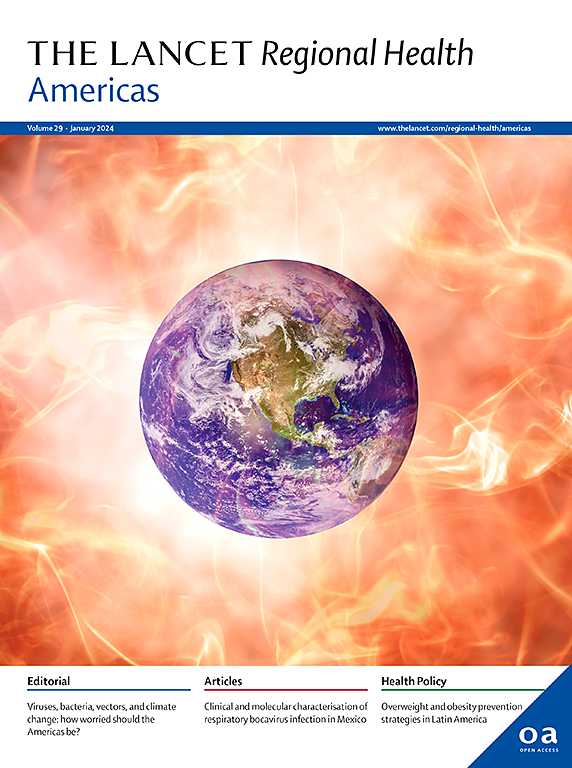The new definition of obesity: an analysis of a population-based survey in an Andean country
IF 7
Q1 HEALTH CARE SCIENCES & SERVICES
引用次数: 0
Abstract
Background
Traditional obesity classification based on body mass index (BMI) fails to capture body fat distribution or clinical dysfunction, and may therefore fail to identify people at highest cardiometabolic risk. The Lancet Diabetes & Endocrinology Commission recently proposed a new framework distinguishing preclinical from clinical obesity based on excessive adiposity and clinical dysfunction. We aimed to estimate the prevalence of clinical and preclinical obesity in Peruvian adults using the Commission’s criteria and adapted regional cutoffs, and to generate ethnicity-specific reference curves for waist circumference (WC) and waist-to-height ratio (WHtR).
Methods
This cross-sectional analysis used nationally representative data from 2021 to 2023 Peruvian Demographic and Health Surveys (ENDES), including 84,622 adults aged ≥20 years. Clinical obesity was defined as excess body fat (BMI, WC, or WHtR) plus diabetes or hypertension diagnosis. Preclinical obesity was defined as excess body fat without clinical dysfunction. Age-adjusted prevalence estimates were calculated using four anthropometric criteria and stratified by sex. Ethnicity-specific WC and WHtR reference curves were generated using GAMLSS models, stratified by age and sex.
Findings
A total of 84,622 participants were included in the study. Among these participants, mean age was 44.1 (range: 20–97) years, and 48,300 participants (51.7%) were female. Clinical obesity age-adjusted prevalence ranged from 15.7% to 22.1%, and preclinical obesity from 28.7% to 53.8%, depending on cutoffs used. Up to 13.5% of individuals with normal BMI and 21% of those overweight met criteria for clinical obesity. Women showed the highest prevalence estimates of preclinical obesity, ranging from 33.4% to 65.8%, whereas men reached their highest prevalence (41.3%) when the International Diabetes Federation (IDF) cutoffs were applied. In the case of clinical obesity, women had higher prevalence estimates of clinical obesity when applying the Lancet Commission approach (18.7%) and the Peruvian national guidelines (21.4%). Men showed higher prevalence estimates when using the cutoffs proposed by the Latin American Consortium of Studies in Obesity (LASO) (16.8%) and the IDF (22.8%). Reference curves showed that Quechua-Aymara individuals had lower WC and WHtR values compared to Afro-Peruvian and other groups at the 97th percentile, in both men and women.
Interpretation
Reliance on BMI alone underestimates a large proportion of clinically relevant cases. Incorporating WC-measurements and clinical dysfunction into diagnostic frameworks could improve identification, prevention, and policy responses to obesity in Peru and similar settings.
Funding
The authors received no financial support.
肥胖的新定义:对一个安第斯国家人口调查的分析
基于身体质量指数(BMI)的传统肥胖分类无法捕捉体脂分布或临床功能障碍,因此可能无法识别心脏代谢风险最高的人群。《柳叶刀》糖尿病与内分泌委员会最近提出了一个基于过度肥胖和临床功能障碍区分临床前肥胖和临床肥胖的新框架。我们的目的是使用委员会的标准和适应的区域截止值来估计秘鲁成年人临床和临床前肥胖的患病率,并生成腰围(WC)和腰高比(WHtR)的种族特定参考曲线。方法横断面分析使用2021年至2023年秘鲁人口与健康调查(ENDES)的全国代表性数据,包括84,622名年龄≥20岁的成年人。临床肥胖被定义为身体脂肪过多(BMI, WC或WHtR)加上糖尿病或高血压诊断。临床前肥胖被定义为无临床功能障碍的体脂过剩。使用四种人体测量标准并按性别分层计算年龄校正患病率估计值。使用GAMLSS模型生成种族特异性WC和WHtR参考曲线,按年龄和性别分层。总共有84,622名参与者参与了这项研究。这些参与者的平均年龄为44.1岁(范围:20-97岁),48,300名参与者(51.7%)为女性。临床肥胖年龄调整患病率从15.7%到22.1%不等,临床前肥胖从28.7%到53.8%不等,这取决于所使用的截止值。高达13.5%的BMI正常者和21%的超重者符合临床肥胖标准。女性显示出最高的临床前肥胖患病率,从33.4%到65.8%不等,而当采用国际糖尿病联合会(IDF)的截止值时,男性的患病率达到最高(41.3%)。在临床肥胖的情况下,采用《柳叶刀》委员会方法(18.7%)和秘鲁国家指南(21.4%)时,妇女的临床肥胖患病率估计较高。当使用拉丁美洲肥胖研究协会(LASO)(16.8%)和IDF(22.8%)提出的截止值时,男性的患病率估计更高。参考曲线显示,与非裔秘鲁人和其他群体相比,克丘亚-艾马拉人的WC和WHtR值在男性和女性中均低于第97百分位。单纯依赖BMI会低估很大比例的临床相关病例。将腰围测量和临床功能障碍纳入诊断框架可以改善秘鲁和类似国家对肥胖的识别、预防和政策应对。作者没有得到任何财政支持。
本文章由计算机程序翻译,如有差异,请以英文原文为准。
求助全文
约1分钟内获得全文
求助全文
来源期刊

Lancet Regional Health-Americas
Multiple-
CiteScore
8.00
自引率
0.00%
发文量
0
期刊介绍:
The Lancet Regional Health – Americas, an open-access journal, contributes to The Lancet's global initiative by focusing on health-care quality and access in the Americas. It aims to advance clinical practice and health policy in the region, promoting better health outcomes. The journal publishes high-quality original research advocating change or shedding light on clinical practice and health policy. It welcomes submissions on various regional health topics, including infectious diseases, non-communicable diseases, child and adolescent health, maternal and reproductive health, emergency care, health policy, and health equity.
 求助内容:
求助内容: 应助结果提醒方式:
应助结果提醒方式:


